yolo v3 pytorch版本(转载)
文章目录
- 一、预测部分
- 1、主题网络darknet53介绍
- 2、从特征获取预测结果
- 3、预测结果的解码
- 4、在原图上进行绘制
- 二、训练部分
- 1、计算loss所需参数
- 2、pred是什么
- 3、target是什么。
- 4、loss的计算过程
- 训练自己的yolo3模型
版权声明:本文为CSDN博主「Bubbliiiing」的原创文章,转载请附上原文出处链接及本声明。
原文链接: https://blog.csdn.net/weixin_44791964/article/details/105310627)
源码下载
https://github.com/bubbliiiing/yolo3-pytorch
喜欢的可以点个star噢。
一、预测部分
1、主题网络darknet53介绍
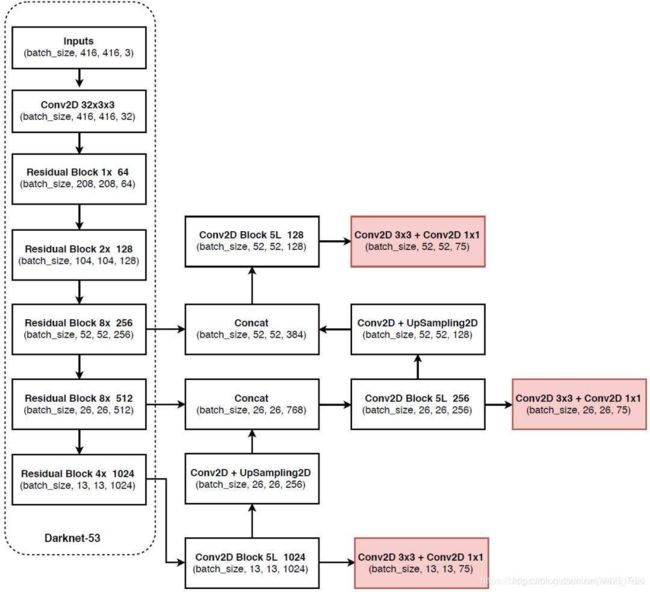
YOLOv3相比于之前的yolo1和yolo2,改进较大,主要改进方向有:
1、主干网络修改为darknet53,其重要特点是使用了残差网络Residual,darknet53中的残差卷积就是进行一次3X3、步长为2的卷积,然后保存该卷积layer,再进行一次1X1的卷积和一次3X3的卷积,并把这个结果加上layer作为最后的结果, 残差网络的特点是容易优化,并且能够通过增加相当的深度来提高准确率。其内部的残差块使用了跳跃连接,缓解了在深度神经网络中增加深度带来的梯度消失问题。
2、darknet53的每一个卷积部分使用了特有的DarknetConv2D结构,每一次卷积的时候进行l2正则化,完成卷积后进行BatchNormalization标准化与LeakyReLU。普通的ReLU是将所有的负值都设为零,Leaky ReLU则是给所有负值赋予一个非零斜率。以数学的方式我们可以表示为:
![]()
实现代码为:
import torch
import torch.nn as nn
import math
from collections import OrderedDict
# 基本的darknet块
class BasicBlock(nn.Module):
def __init__(self, inplanes, planes):
super(BasicBlock, self).__init__()
self.conv1 = nn.Conv2d(inplanes, planes[0], kernel_size=1,
stride=1, padding=0, bias=False)
self.bn1 = nn.BatchNorm2d(planes[0])
self.relu1 = nn.LeakyReLU(0.1)
self.conv2 = nn.Conv2d(planes[0], planes[1], kernel_size=3,
stride=1, padding=1, bias=False)
self.bn2 = nn.BatchNorm2d(planes[1])
self.relu2 = nn.LeakyReLU(0.1)
def forward(self, x):
residual = x
out = self.conv1(x)
out = self.bn1(out)
out = self.relu1(out)
out = self.conv2(out)
out = self.bn2(out)
out = self.relu2(out)
out += residual
return out
class DarkNet(nn.Module):
def __init__(self, layers):
super(DarkNet, self).__init__()
self.inplanes = 32
self.conv1 = nn.Conv2d(3, self.inplanes, kernel_size=3, stride=1, padding=1, bias=False)
self.bn1 = nn.BatchNorm2d(self.inplanes)
self.relu1 = nn.LeakyReLU(0.1)
self.layer1 = self._make_layer([32, 64], layers[0])
self.layer2 = self._make_layer([64, 128], layers[1])
self.layer3 = self._make_layer([128, 256], layers[2])
self.layer4 = self._make_layer([256, 512], layers[3])
self.layer5 = self._make_layer([512, 1024], layers[4])
self.layers_out_filters = [64, 128, 256, 512, 1024]
# 进行权值初始化
for m in self.modules():
if isinstance(m, nn.Conv2d):
n = m.kernel_size[0] * m.kernel_size[1] * m.out_channels
m.weight.data.normal_(0, math.sqrt(2. / n))
elif isinstance(m, nn.BatchNorm2d):
m.weight.data.fill_(1)
m.bias.data.zero_()
def _make_layer(self, planes, blocks):
layers = []
# 下采样,步长为2,卷积核大小为3
layers.append(("ds_conv", nn.Conv2d(self.inplanes, planes[1], kernel_size=3,
stride=2, padding=1, bias=False)))
layers.append(("ds_bn", nn.BatchNorm2d(planes[1])))
layers.append(("ds_relu", nn.LeakyReLU(0.1)))
# 加入darknet模块
self.inplanes = planes[1]
for i in range(0, blocks):
layers.append(("residual_{}".format(i), BasicBlock(self.inplanes, planes)))
return nn.Sequential(OrderedDict(layers))
def forward(self, x):
x = self.conv1(x)
x = self.bn1(x)
x = self.relu1(x)
x = self.layer1(x)
x = self.layer2(x)
out3 = self.layer3(x)
out4 = self.layer4(out3)
out5 = self.layer5(out4)
return out3, out4, out5
def darknet53(pretrained, **kwargs):
model = DarkNet([1, 2, 8, 8, 4])
if pretrained:
if isinstance(pretrained, str):
model.load_state_dict(torch.load(pretrained))
else:
raise Exception("darknet request a pretrained path. got [{}]".format(pretrained))
return model
2、从特征获取预测结果
![]()
1、在特征利用部分,yolo3提取多特征层进行目标检测,一共提取三个特征层,三个特征层位于主干部分darknet53的不同位置,分别位于中间层,中下层,底层,三个特征层的shape分别为(52,52,256)、(26,26,512)、(13,13,1024)。
2、三个特征层进行5次卷积处理,处理完后一部分用于输出该特征层对应的预测结果,一部分用于进行反卷积UmSampling2d后与其它特征层进行结合。
3、输出层的shape分别为(13,13,75),(26,26,75),(52,52,75),最后一个维度为75是因为该图是基于voc数据集的,它的类为20种,yolo3只有针对每一个特征层存在3个先验框,所以最后维度为3x25;
如果使用的是coco训练集,类则为80种,最后的维度应该为255 = 3x85,三个特征层的shape为(13,13,255),(26,26,255),(52,52,255)
其实际情况就是,输入N张416x416的图片,在经过多层的运算后,会输出三个shape分别为**(N,13,13,255),(N,26,26,255),(N,52,52,255)**的数据,对应每个图分为13x13、26x26、52x52的网格上3个先验框的位置。
实现代码如下:
import torch
import torch.nn as nn
from collections import OrderedDict
from nets.darknet import darknet53
def conv2d(filter_in, filter_out, kernel_size):
pad = (kernel_size - 1) // 2 if kernel_size else 0
return nn.Sequential(OrderedDict([
("conv", nn.Conv2d(filter_in, filter_out, kernel_size=kernel_size, stride=1, padding=pad, bias=False)),
("bn", nn.BatchNorm2d(filter_out)),
("relu", nn.LeakyReLU(0.1)),
]))
def make_last_layers(filters_list, in_filters, out_filter):
m = nn.ModuleList([
conv2d(in_filters, filters_list[0], 1),
conv2d(filters_list[0], filters_list[1], 3),
conv2d(filters_list[1], filters_list[0], 1),
conv2d(filters_list[0], filters_list[1], 3),
conv2d(filters_list[1], filters_list[0], 1),
conv2d(filters_list[0], filters_list[1], 3),
nn.Conv2d(filters_list[1], out_filter, kernel_size=1,
stride=1, padding=0, bias=True)
])
return m
class YoloBody(nn.Module):
def __init__(self, config):
super(YoloBody, self).__init__()
self.config = config
# backbone
self.backbone = darknet53(None)
out_filters = self.backbone.layers_out_filters
# last_layer0
final_out_filter0 = len(config["yolo"]["anchors"][0]) * (5 + config["yolo"]["classes"])
self.last_layer0 = make_last_layers([512, 1024], out_filters[-1], final_out_filter0)
# embedding1
final_out_filter1 = len(config["yolo"]["anchors"][1]) * (5 + config["yolo"]["classes"])
self.last_layer1_conv = conv2d(512, 256, 1)
self.last_layer1_upsample = nn.Upsample(scale_factor=2, mode='nearest')
self.last_layer1 = make_last_layers([256, 512], out_filters[-2] + 256, final_out_filter1)
# embedding2
final_out_filter2 = len(config["yolo"]["anchors"][2]) * (5 + config["yolo"]["classes"])
self.last_layer2_conv = conv2d(256, 128, 1)
self.last_layer2_upsample = nn.Upsample(scale_factor=2, mode='nearest')
self.last_layer2 = make_last_layers([128, 256], out_filters[-3] + 128, final_out_filter2)
def forward(self, x):
def _branch(last_layer, layer_in):
for i, e in enumerate(last_layer):
layer_in = e(layer_in)
if i == 4:
out_branch = layer_in
return layer_in, out_branch
# backbone
x2, x1, x0 = self.backbone(x)
# yolo branch 0
out0, out0_branch = _branch(self.last_layer0, x0)
# yolo branch 1
x1_in = self.last_layer1_conv(out0_branch)
x1_in = self.last_layer1_upsample(x1_in)
x1_in = torch.cat([x1_in, x1], 1)
out1, out1_branch = _branch(self.last_layer1, x1_in)
# yolo branch 2
x2_in = self.last_layer2_conv(out1_branch)
x2_in = self.last_layer2_upsample(x2_in)
x2_in = torch.cat([x2_in, x2], 1)
out2, _ = _branch(self.last_layer2, x2_in)
return out0, out1, out2
3、预测结果的解码
由第二步我们可以获得三个特征层的预测结果,shape分别为**(N,13,13,255),(N,26,26,255),(N,52,52,255)**的数据,对应每个图分为13x13、26x26、52x52的网格上3个预测框的位置。
但是这个预测结果并不对应着最终的预测框在图片上的位置,还需要解码才可以完成。
此处要讲一下yolo3的预测原理,yolo3的3个特征层分别将整幅图分为13x13、26x26、52x52的网格,每个网络点负责一个区域的检测。
我们知道特征层的预测结果对应着三个预测框的位置,我们先将其reshape一下,其结果为**(N,13,13,3,85),(N,26,26,3,85),(N,52,52,3,85)。**
最后一个维度中的85包含了4+1+80,分别代表x_offset、y_offset、h和w、置信度、分类结果。
yolo3的解码过程就是将每个网格点加上它对应的x_offset和y_offset,加完后的结果就是预测框的中心,然后再利用 **先验框和h、w结合 计算出预测框的长和宽。**这样就能得到整个预测框的位置了。
![]()
当然得到最终的预测结构后还要进行得分排序与非极大抑制筛选
这一部分基本上是所有目标检测通用的部分。不过该项目的处理方式与其它项目不同。其对于每一个类进行判别。
1、取出每一类得分大于self.obj_threshold的框和得分。
2、利用框的位置和得分进行非极大抑制。
实现代码如下,
class DecodeBox(nn.Module):
def __init__(self, anchors, num_classes, img_size):
super(DecodeBox, self).__init__()
self.anchors = anchors
self.num_anchors = len(anchors)
self.num_classes = num_classes
self.bbox_attrs = 5 + num_classes
self.img_size = img_size
def forward(self, input):
batch_size = input.size(0)
input_height = input.size(2)
input_width = input.size(3)
# 计算步长
stride_h = self.img_size[1] / input_height
stride_w = self.img_size[0] / input_width
# 归一到特征层上
scaled_anchors = [(anchor_width / stride_w, anchor_height / stride_h) for anchor_width, anchor_height in self.anchors]
# 对预测结果进行resize
prediction = input.view(batch_size, self.num_anchors,
self.bbox_attrs, input_height, input_width).permute(0, 1, 3, 4, 2).contiguous()
# 先验框的中心位置的调整参数
x = torch.sigmoid(prediction[..., 0])
y = torch.sigmoid(prediction[..., 1])
# 先验框的宽高调整参数
w = prediction[..., 2] # Width
h = prediction[..., 3] # Height
# 获得置信度,是否有物体
conf = torch.sigmoid(prediction[..., 4])
# 种类置信度
pred_cls = torch.sigmoid(prediction[..., 5:]) # Cls pred.
FloatTensor = torch.cuda.FloatTensor if x.is_cuda else torch.FloatTensor
LongTensor = torch.cuda.LongTensor if x.is_cuda else torch.LongTensor
# 生成网格,先验框中心,网格左上角
grid_x = torch.linspace(0, input_width - 1, input_width).repeat(input_width, 1).repeat(
batch_size * self.num_anchors, 1, 1).view(x.shape).type(FloatTensor)
grid_y = torch.linspace(0, input_height - 1, input_height).repeat(input_height, 1).t().repeat(
batch_size * self.num_anchors, 1, 1).view(y.shape).type(FloatTensor)
# 生成先验框的宽高
anchor_w = FloatTensor(scaled_anchors).index_select(1, LongTensor([0]))
anchor_h = FloatTensor(scaled_anchors).index_select(1, LongTensor([1]))
anchor_w = anchor_w.repeat(batch_size, 1).repeat(1, 1, input_height * input_width).view(w.shape)
anchor_h = anchor_h.repeat(batch_size, 1).repeat(1, 1, input_height * input_width).view(h.shape)
# 计算调整后的先验框中心与宽高
pred_boxes = FloatTensor(prediction[..., :4].shape)
pred_boxes[..., 0] = x.data + grid_x
pred_boxes[..., 1] = y.data + grid_y
pred_boxes[..., 2] = torch.exp(w.data) * anchor_w
pred_boxes[..., 3] = torch.exp(h.data) * anchor_h
# 用于将输出调整为相对于416x416的大小
_scale = torch.Tensor([stride_w, stride_h] * 2).type(FloatTensor)
output = torch.cat((pred_boxes.view(batch_size, -1, 4) * _scale,
conf.view(batch_size, -1, 1), pred_cls.view(batch_size, -1, self.num_classes)), -1)
return output.data
4、在原图上进行绘制
通过第三步,我们可以获得预测框在原图上的位置,而且这些预测框都是经过筛选的。这些筛选后的框可以直接绘制在图片上,就可以获得结果了。
二、训练部分
1、计算loss所需参数
在计算loss的时候,实际上是pred和target之间的对比:
pred就是网络的预测结果。
target就是网络的真实框情况。
2、pred是什么
对于yolo3的模型来说,网络最后输出的内容就是三个特征层每个网格点对应的预测框及其种类,即三个特征层分别对应着图片被分为不同size的网格后,每个网格点上三个先验框对应的位置、置信度及其种类。
输出层的shape分别为**(13,13,75),(26,26,75),(52,52,75),最后一个维度为75是因为是基于voc数据集的,它的类为20种,yolo3只有针对每一个特征层存在3个先验框,所以最后维度为3x25;
如果使用的是coco训练集,类则为80种,最后的维度应该为255 = 3x85,三个特征层的shape为(13,13,255),(26,26,255),(52,52,255)**
现在的y_pre还是没有解码的,解码了之后才是真实图像上的情况。
3、target是什么。
target就是一个真实图像中,真实框的情况。
第一个维度是batch_size,第二个维度是每一张图片里面真实框的数量,第三个维度内部是真实框的信息,包括位置以及种类。
4、loss的计算过程
拿到pred和target后,不可以简单的减一下作为对比,需要进行如下步骤。
- 判断真实框在图片中的位置,判断其属于哪一个网格点去检测
- 判断真实框和哪个先验框重合程度最高。
- 计算该网格点应该有怎么样的预测结果才能获得真实框
- 对所有真实框进行如上处理。
- 获得网络应该有的预测结果,将其与实际的预测结果对比。
from random import shuffle
import numpy as np
import torch
import torch.nn as nn
import math
import torch.nn.functional as F
from matplotlib.colors import rgb_to_hsv, hsv_to_rgb
from PIL import Image
from utils.utils import bbox_iou
def clip_by_tensor(t,t_min,t_max):
t=t.float()
result = (t >= t_min).float() * t + (t < t_min).float() * t_min
result = (result <= t_max).float() * result + (result > t_max).float() * t_max
return result
def MSELoss(pred,target):
return (pred-target)**2
def BCELoss(pred,target):
epsilon = 1e-7
pred = clip_by_tensor(pred, epsilon, 1.0 - epsilon)
output = -target * torch.log(pred) - (1.0 - target) * torch.log(1.0 - pred)
return output
class YOLOLoss(nn.Module):
def __init__(self, anchors, num_classes, img_size):
super(YOLOLoss, self).__init__()
self.anchors = anchors
self.num_anchors = len(anchors)
self.num_classes = num_classes
self.bbox_attrs = 5 + num_classes
self.img_size = img_size
self.ignore_threshold = 0.5
self.lambda_xy = 1.0
self.lambda_wh = 1.0
self.lambda_conf = 1.0
self.lambda_cls = 1.0
def forward(self, input, targets=None):
# 一共多少张图片
bs = input.size(0)
# 特征层的高
in_h = input.size(2)
# 特征层的宽
in_w = input.size(3)
# 计算步长
stride_h = self.img_size[1] / in_h
stride_w = self.img_size[0] / in_w
# 把先验框的尺寸调整成特征层大小的形式
scaled_anchors = [(a_w / stride_w, a_h / stride_h) for a_w, a_h in self.anchors]
# reshape
prediction = input.view(bs, int(self.num_anchors/3),
self.bbox_attrs, in_h, in_w).permute(0, 1, 3, 4, 2).contiguous()
# 对prediction预测进行调整
x = torch.sigmoid(prediction[..., 0]) # Center x
y = torch.sigmoid(prediction[..., 1]) # Center y
w = prediction[..., 2] # Width
h = prediction[..., 3] # Height
conf = torch.sigmoid(prediction[..., 4]) # Conf
pred_cls = torch.sigmoid(prediction[..., 5:]) # Cls pred.
# 找到哪些先验框内部包含物体
mask, noobj_mask, tx, ty, tw, th, tconf, tcls, box_loss_scale_x, box_loss_scale_y =\
self.get_target(targets, scaled_anchors,
in_w, in_h,
self.ignore_threshold)
noobj_mask = self.get_ignore(prediction, targets, scaled_anchors, in_w, in_h, noobj_mask)
box_loss_scale_x = (2-box_loss_scale_x).cuda()
box_loss_scale_y = (2-box_loss_scale_y).cuda()
box_loss_scale = box_loss_scale_x*box_loss_scale_y
mask, noobj_mask = mask.cuda(), noobj_mask.cuda()
tx, ty, tw, th = tx.cuda(), ty.cuda(), tw.cuda(), th.cuda()
tconf, tcls = tconf.cuda(), tcls.cuda()
# losses.
loss_x = torch.sum(BCELoss(x, tx) / bs * box_loss_scale * mask)
loss_y = torch.sum(BCELoss(y, ty) / bs * box_loss_scale * mask)
loss_w = torch.sum(MSELoss(w, tw) / bs * 0.5 * box_loss_scale * mask)
loss_h = torch.sum(MSELoss(h, th) / bs * 0.5 * box_loss_scale * mask)
loss_conf = torch.sum(BCELoss(conf, mask) * mask / bs) + \
torch.sum(BCELoss(conf, mask) * noobj_mask / bs)
loss_cls = torch.sum(BCELoss(pred_cls[mask == 1], tcls[mask == 1])/bs)
loss = loss_x * self.lambda_xy + loss_y * self.lambda_xy + \
loss_w * self.lambda_wh + loss_h * self.lambda_wh + \
loss_conf * self.lambda_conf + loss_cls * self.lambda_cls
# print(loss, loss_x.item() + loss_y.item(), loss_w.item() + loss_h.item(),
# loss_conf.item(), loss_cls.item(), \
# torch.sum(mask),torch.sum(noobj_mask))
return loss, loss_x.item(), loss_y.item(), loss_w.item(), \
loss_h.item(), loss_conf.item(), loss_cls.item()
def get_target(self, target, anchors, in_w, in_h, ignore_threshold):
# 计算一共有多少张图片
bs = len(target)
# 获得先验框
anchor_index = [[0,1,2],[3,4,5],[6,7,8]][[13,26,52].index(in_w)]
subtract_index = [0,3,6][[13,26,52].index(in_w)]
# 创建全是0或者全是1的阵列
mask = torch.zeros(bs, int(self.num_anchors/3), in_h, in_w, requires_grad=False)
noobj_mask = torch.ones(bs, int(self.num_anchors/3), in_h, in_w, requires_grad=False)
tx = torch.zeros(bs, int(self.num_anchors/3), in_h, in_w, requires_grad=False)
ty = torch.zeros(bs, int(self.num_anchors/3), in_h, in_w, requires_grad=False)
tw = torch.zeros(bs, int(self.num_anchors/3), in_h, in_w, requires_grad=False)
th = torch.zeros(bs, int(self.num_anchors/3), in_h, in_w, requires_grad=False)
tconf = torch.zeros(bs, int(self.num_anchors/3), in_h, in_w, requires_grad=False)
tcls = torch.zeros(bs, int(self.num_anchors/3), in_h, in_w, self.num_classes, requires_grad=False)
box_loss_scale_x = torch.zeros(bs, int(self.num_anchors/3), in_h, in_w, requires_grad=False)
box_loss_scale_y = torch.zeros(bs, int(self.num_anchors/3), in_h, in_w, requires_grad=False)
for b in range(bs):
for t in range(target[b].shape[0]):
# 计算出在特征层上的点位
gx = target[b][t, 0] * in_w
gy = target[b][t, 1] * in_h
gw = target[b][t, 2] * in_w
gh = target[b][t, 3] * in_h
# 计算出属于哪个网格
gi = int(gx)
gj = int(gy)
# 计算真实框的位置
gt_box = torch.FloatTensor(np.array([0, 0, gw, gh])).unsqueeze(0)
# 计算出所有先验框的位置
anchor_shapes = torch.FloatTensor(np.concatenate((np.zeros((self.num_anchors, 2)),
np.array(anchors)), 1))
# 计算重合程度
anch_ious = bbox_iou(gt_box, anchor_shapes)
# Find the best matching anchor box
best_n = np.argmax(anch_ious)
if best_n not in anchor_index:
continue
# Masks
if (gj < in_h) and (gi < in_w):
best_n = best_n - subtract_index
# 判定哪些先验框内部真实的存在物体
noobj_mask[b, best_n, gj, gi] = 0
mask[b, best_n, gj, gi] = 1
# 计算先验框中心调整参数
tx[b, best_n, gj, gi] = gx - gi
ty[b, best_n, gj, gi] = gy - gj
# 计算先验框宽高调整参数
tw[b, best_n, gj, gi] = math.log(gw / anchors[best_n+subtract_index][0])
th[b, best_n, gj, gi] = math.log(gh / anchors[best_n+subtract_index][1])
# 用于获得xywh的比例
box_loss_scale_x[b, best_n, gj, gi] = target[b][t, 2]
box_loss_scale_y[b, best_n, gj, gi] = target[b][t, 3]
# 物体置信度
tconf[b, best_n, gj, gi] = 1
# 种类
tcls[b, best_n, gj, gi, int(target[b][t, 4])] = 1
else:
print('Step {0} out of bound'.format(b))
print('gj: {0}, height: {1} | gi: {2}, width: {3}'.format(gj, in_h, gi, in_w))
continue
return mask, noobj_mask, tx, ty, tw, th, tconf, tcls, box_loss_scale_x, box_loss_scale_y
def get_ignore(self,prediction,target,scaled_anchors,in_w, in_h,noobj_mask):
bs = len(target)
anchor_index = [[0,1,2],[3,4,5],[6,7,8]][[13,26,52].index(in_w)]
scaled_anchors = np.array(scaled_anchors)[anchor_index]
# print(scaled_anchors)
# 先验框的中心位置的调整参数
x_all = torch.sigmoid(prediction[..., 0])
y_all = torch.sigmoid(prediction[..., 1])
# 先验框的宽高调整参数
w_all = prediction[..., 2] # Width
h_all = prediction[..., 3] # Height
for i in range(bs):
x = x_all[i]
y = y_all[i]
w = w_all[i]
h = h_all[i]
FloatTensor = torch.cuda.FloatTensor if x.is_cuda else torch.FloatTensor
LongTensor = torch.cuda.LongTensor if x.is_cuda else torch.LongTensor
# 生成网格,先验框中心,网格左上角
grid_x = torch.linspace(0, in_w - 1, in_w).repeat(in_w, 1).repeat(
int(self.num_anchors/3), 1, 1).view(x.shape).type(FloatTensor)
grid_y = torch.linspace(0, in_h - 1, in_h).repeat(in_h, 1).t().repeat(
int(self.num_anchors/3), 1, 1).view(y.shape).type(FloatTensor)
# 生成先验框的宽高
anchor_w = FloatTensor(scaled_anchors).index_select(1, LongTensor([0]))
anchor_h = FloatTensor(scaled_anchors).index_select(1, LongTensor([1]))
anchor_w = anchor_w.repeat(1, 1, in_h * in_w).view(w.shape)
anchor_h = anchor_h.repeat(1, 1, in_h * in_w).view(h.shape)
# 计算调整后的先验框中心与宽高
pred_boxes = torch.FloatTensor(prediction[0][..., :4].shape)
pred_boxes[..., 0] = x.data + grid_x
pred_boxes[..., 1] = y.data + grid_y
pred_boxes[..., 2] = torch.exp(w.data) * anchor_w
pred_boxes[..., 3] = torch.exp(h.data) * anchor_h
pred_boxes = pred_boxes.view(-1, 4)
for t in range(target[i].shape[0]):
gx = target[i][t, 0] * in_w
gy = target[i][t, 1] * in_h
gw = target[i][t, 2] * in_w
gh = target[i][t, 3] * in_h
gt_box = torch.FloatTensor(np.array([gx, gy, gw, gh])).unsqueeze(0)
anch_ious = bbox_iou(gt_box, pred_boxes, x1y1x2y2=False)
anch_ious = anch_ious.view(x.size())
noobj_mask[i][anch_ious>self.ignore_threshold] = 0
# print(torch.max(anch_ious))
return noobj_mask
训练自己的yolo3模型
yolo3整体的文件夹构架如下:
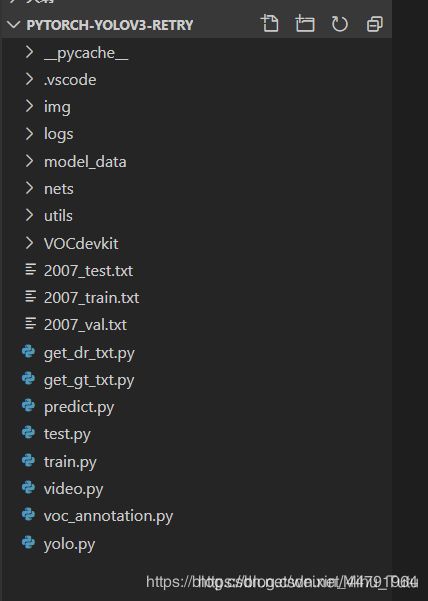
本文使用VOC格式进行训练。
训练前将标签文件放在VOCdevkit文件夹下的VOC2007文件夹下的Annotation中。
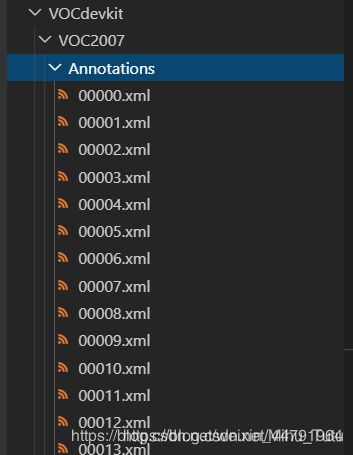
训练前将图片文件放在VOCdevkit文件夹下的VOC2007文件夹下的JPEGImages中。
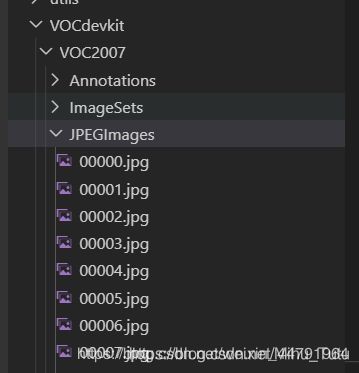
在训练前利用voc2yolo3.py文件生成对应的txt。
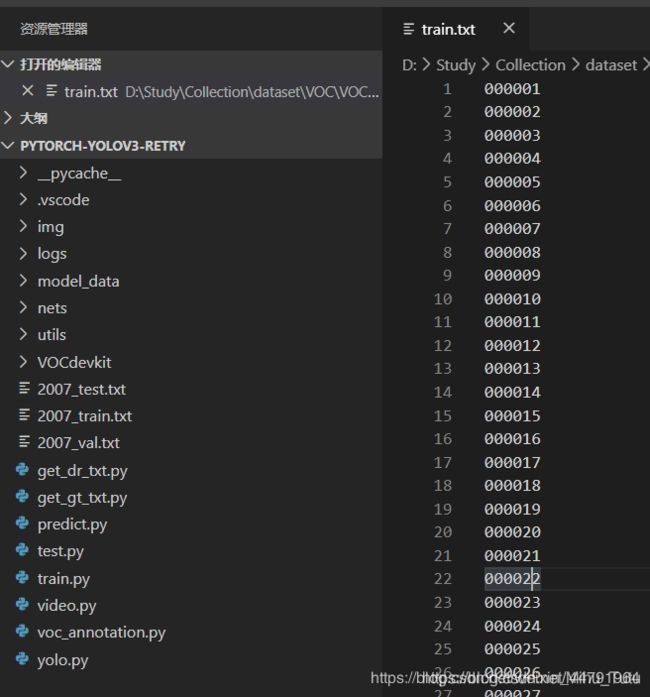
再运行根目录下的voc_annotation.py,运行前需要将classes改成你自己的classes。
classes = ["aeroplane", "bicycle", "bird", "boat", "bottle", "bus", "car", "cat", "chair", "cow", "diningtable", "dog", "horse", "motorbike", "person", "pottedplant", "sheep", "sofa", "train", "tvmonitor"]

就会生成对应的2007_train.txt,每一行对应其图片位置及其真实框的位置。

在训练前需要修改model_data里面的voc_classes.txt文件,需要将classes改成你自己的classes。同时还需要修改utils/config.py文件,修改内部的Num_Classes变成所分的种类的数量。

运行train.py即可开始训练。
